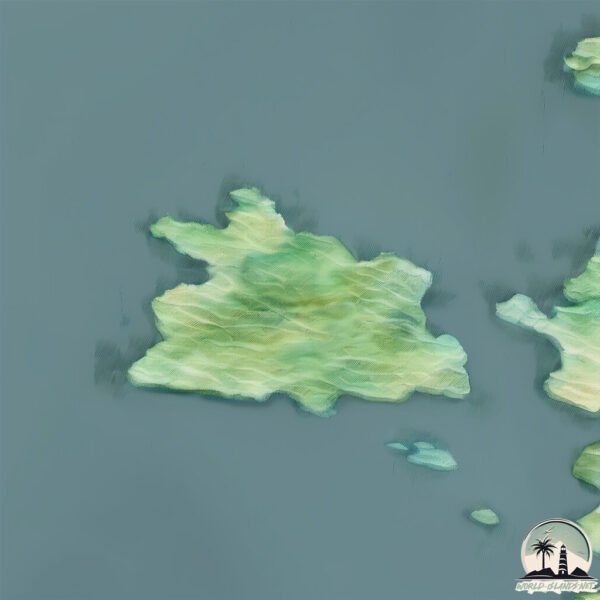Welcome to Aran Island , a Temperate island in the North Atlantic Ocean, part of the majestic Atlantic Ocean. This guide offers a comprehensive overview of what makes Aran Island unique – from its geography and climate to its population, infrastructure, and beyond. Dive into the details:
Geography and size of Aran Island
Size: 18.7 km²Coastline: 29.5 kmOcean: Atlantic OceanSea: North Atlantic OceanContinent: Europe
Aran Island is a Medium Island spanning 19 km² with a coastline of 29 km.
Archipel: British Isles – A group of islands off the northwest coast of mainland Europe, including Great Britain, Ireland, and over 6,000 smaller islands, known for their rich history and cultural diversity.
Tectonic Plate: Eurasia – One of the world’s largest tectonic plates, the Eurasian Plate covers a significant portion of Europe and Asia. It’s characterized by diverse geological features, including the Ural Mountains, the European Plain, and the Himalayas formed from its collision with the Indian Plate.
The geographic heart of the island is pinpointed at these coordinates:
Climate and weather of Aran Island
Climate Zone: TemperateClimate Details: Temperate Oceanic ClimateTemperature: Warm Summer
Climate Characteristics: Known for its moderate year-round temperatures with ample rainfall and no dry season. Warm summers are characteristic.
Topography and nature of Aran Island
Timezone: UTC±00:00Timezone places: Europe/LondonMax. Elevation: 194 m Mean Elevation: 104 mVegetation: Agricultural MosaicTree Coverage: 32%
The mean elevation is 104 m. The highest elevation on the island reaches approximately 194 meters above sea level. The island is characterized by Plains: Flat, low-lying lands characterized by a maximum elevation of up to 200 meters. On islands, plains are typically coastal lowlands or central flat areas.
Dominating Vegetation: Agricultural Mosaic
Vegetation: 10 vegetation zones – Very Highly Diverse Island
Infrastructure and Travelling to Aran Island
Does the island have a public airport? no .
Does the island have a major port? no .
The mean population of Aran Island is 26 per km². Aran Island is Gently Populated. The island belongs to Ireland .
Continuing your journey, Ireland is the next notable island, situated merely km away.
INIS MOR Ultimate Travel Guide | ARAN ISLANDS | Ireland
We've been living in Ireland for 5 years and we've visited many of the most famous places in this incredible country. In this video ...
INIS MOR Ultimate Travel Guide | ARAN ISLANDS | Ireland
We've been living in Ireland for 5 years and we've visited many of the ...
We've been living in Ireland for 5 years and we've visited many of the most famous places in this incredible country. In this video ...
Day Trip to the Beautiful Island of Inis Mór - Exploring the Aran Islands, Ireland
Join me on a breathtaking day trip to Inis Mór, the largest of the ...
Join me on a breathtaking day trip to Inis Mór, the largest of the enchanting Aran Islands off the coast of Ireland. Explore the ...
ARAN ISLANDS | Inisheer's Irish Tradition & Adventure Draws Visitors
Produced by Jim Albritton | Just off the west coast of Ireland, the ...
Produced by Jim Albritton | Just off the west coast of Ireland, the rocky windswept Aran Islands are home to ancient ruins, unique ...
Ireland is classified as Developed region: nonG7: Developed economies outside of the Group of Seven, characterized by high income and advanced economic structures. The level of income is High income: OECD.
News – Latest Updates and Headlines from Aran Island
Stay informed with the most recent news and important headlines from Aran Island. Here’s a roundup of the latest developments.
Loading...
Please note: The data used here has been primarily extracted from satellite readings. Deviations from exact values may occur, particularly regarding the height of elevations and population density. Land area and coastline measurements refer to average values at mean high tide.

